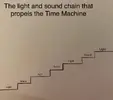The speed of sound is approximately 767 mph and the speed of light is 670,616,629 mph.
If we could somehow upload sound into a beam of light then therefore theoretically that sound in the beam of light should be travelling exactly 767 mph faster than the speed of light, and then upload light into that sound and therefore now light would be travelling twice as fast plus the speed of sound, and keep repeating that to always multiply the speed of light, and theoretically you can do that forever to infinity therefore there would be no limit to how fast you can travel. It will become like a chain, the light and sound chain that propels the Time Machine.

Please let me know what you think about this idea.
Thank You
If we could somehow upload sound into a beam of light then therefore theoretically that sound in the beam of light should be travelling exactly 767 mph faster than the speed of light, and then upload light into that sound and therefore now light would be travelling twice as fast plus the speed of sound, and keep repeating that to always multiply the speed of light, and theoretically you can do that forever to infinity therefore there would be no limit to how fast you can travel. It will become like a chain, the light and sound chain that propels the Time Machine.

Please let me know what you think about this idea.
Thank You
Last edited:
